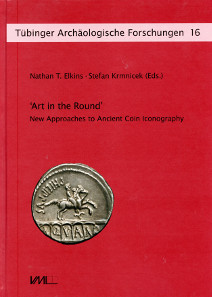by Ursula Kampmann
translated by Annika Backe
August 13, 2015 – What does iconography mean? It is quite simple: “eikon” means image and “graphein” means to write. Hence, not only text can be used to write on coins, but, above all, images. It sounds pretty straightforward – as long as you do not account for the possibility of misinterpretation: to two different societies, the same image can mean something completely different.
Nathan T. Elkins and Stefan Krmnicek, Art in the Round. New Approaches to Ancient Coin Iconography. Rahden / Westf. 2014, Verlag Marie Leidorf GmbH. 184 pages. 158 illustrations. Hardcover, 21 x 29.7 cm. ISBN 978-3-89646-996-0. 53.50 Euros.
This is the approach Stefan Krmnicek and Nathan T. Elkins follow in their foreword. They got me hooked on the very first page. Eagerly I read what they said about a “no dinosaur” button that did not mean the same to the different participants at a joint meeting of the Archaeological Institute of America and the American Philological Association at all. Thus, iconography is not just the art of writing with images but likewise the art of being understood as well as of correctly interpreting the image in its context.
It is this “correctly” what the twelve papers revolve around. Twelve papers that look at the Greek and the Roman world, divided according to three different approaches. In Section I the researchers work with comparisons in that they compare coins with archaeological objects on the one hand and with written sources on the other hand. Section II takes the subject of the depiction as a starting point. This involves making comparisons as well but the approach is different. The coin imagery is the point of departure here, with the relevant material being subsequently gathered. And in Section III the approach itself is reflected upon.
The examples are mainly taken from Roman numismatics, from the “headquarters” but likewise from the “province”. Greek topics are also addressed, like the depictions of mussels on coins, or representations of deities and shifts in Seleucid iconography. The broad spectrum likewise covers a thorough examination of the Portus Ostiensis on the sestertii of Nero and an overview of the iconography of the Roman colonies in Macedonia.
What remains of this conference is a particularly inspiring text volume that deserves merit for shifting the focus back on what a coin does best: conveying a message from here to there, from Rome to Ephesus, from the past to us. The individual contributions add together and illustrate the number of possibilities of academic research. As was said above, it is an inspiring book that I would recommend not only to people who are interested in ancient coins. On the contrary, the articles likewise benefit those with an interest in modern coins and medals, providing suggestions as to exploit the material better still.
For placing an order for this book, please access this link.
Learn more about the conference here.




